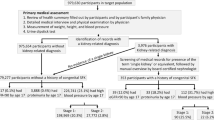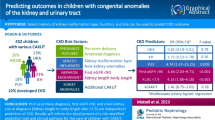Abstract
Background
Solitary functioning kidney (SFK) is an important condition in the spectrum of congenital anomalies of the kidney and urinary tract. The aim of this study was to describe the risk factors for renal injury in a cohort of patients with congenital SFK.
Methods
In this retrospective cohort study, 162 patients with SFK were systematically followed up (median, 8.5 years). The primary endpoint was time until the occurrence of a composite event of renal injury, which includes proteinuria, hypertension, and chronic kidney disease (CKD). A predictive model was developed using Cox proportional hazards model and evaluated by c statistics.
Results
Among 162 children with SFK included in the analysis, 132 (81.5%) presented multicystic dysplastic kidney, 20 (12.3%) renal hypodysplasia, and 10 (6.2%) unilateral renal agenesis. Of 162 patients included in the analysis, 10 (6.2%) presented persistent proteinuria, 11 (6.8%) had hypertension, 9 (5.6%) developed CKD stage ≥ 3, and 18 (11%) developed the composite outcome. After adjustment by the Cox model, three variables remained as independent predictors of the composite event: creatinine (HR, 3.93; P < 0.001), recurrent urinary tract infection (UTI) (HR, 5.05; P = 0.002), and contralateral renal length at admission (HR, 0.974; P = 0.002). The probability of the composite event at 10 years of age was estimated as 3%, 11%, and 56% for patients assigned to the low-risk, medium-risk, and high-risk groups, respectively (P < 0.001).
Conclusion
Our findings have shown an overall low risk of renal injury for most of infants with congenital SFK. Nevertheless, our prediction model enabled the identification of a subgroup of patients with an increased risk of renal injury over time.



Similar content being viewed by others
References
Loane M, Dolk H, Kelly A, Teljeur C, Greenlees R, Densem J (2011) Paper 4: EUROCAT statistical monitoring: identification and investigation of ten year trends of congenital anomalies in Europe. Birth Defects Res A Clin Mol Teratol 91(Suppl 1):S31–S43
Wiesel A, Queisser-Luft A, Clementi M, Bianca S, Stoll C (2005) Prenatal detection of congenital renal malformations by fetal ultrasonographic examination: an analysis of 709,030 births in 12 European countries. Eur J Med Genet 48:131–144
Westland R, Schreuder MF, van Goudoever JB, Sanna-Cherchi S, van Wijk JA (2014) Clinical implications of the solitary functioning kidney. Clin J Am Soc Nephrol 9:978–986
Sanna-Cherchi S, Ravani P, Corbani V, Parodi S, Haupt R, Piaggio G, Innocenti ML, Somenzi D, Trivelli A, Caridi G, Izzi C, Scolari F, Mattioli G, Allegri L, Ghiggeri GM (2009) Renal outcome in patients with congenital anomalies of the kidney and urinary tract. Kidney Int 76:528–533
Westland R, Schreuder MF, Ket JC, van Wijk JA (2013) Unilateral renal agenesis: a systematic review on associated anomalies and renal injury. Nephrol Dial Transplant 28:1844–1855
La Scola C, Ammenti A, Puccio G, Lega MV, De Mutiis C, Guiducci C, De Petris L, Perretta R, Venturoli V, Vergine G, Zucchini A, Montini G (2016) Congenital solitary kidney in children: size matters. J Urol 196:1250–1256
Corbani V, Ghiggeri GM, Sanna-Cherchi S (2011) Congenital solitary functioning kidneys: which ones warrant follow-up into adult life? Nephrol Dial Transplant 26:1458–1460
Hayes WN, Watson AR, Trent AMSG (2012) Unilateral multicystic dysplastic kidney: does initial size matter? Pediatr Nephrol 27:1335–1340
Vu KH, Van Dyck M, Daniels H, Proesmans W (2008) Renal outcome of children with one functioning kidney from birth. A study of 99 patients and a review of the literature. Eur J Pediatr 167:885–890
Avni EF, Thoua Y, Lalmand B, Didier F, Droulle P, Schulman CC (1986) Multicystic dysplastic kidney: evolving concepts. In utero diagnosis and post-natal follow-up by ultrasound. Ann Radiol 29:663–668
Avni EF, Thoua Y, Van Gansbeke D, Matos C, Didier F, Droulez P, Schulman CC (1987) Development of the hypodysplastic kidney: contribution of antenatal US diagnosis. Radiology 164:123–125
Rabelo EA, Oliveira EA, Diniz JS, Silva JM, Filgueiras MT, Pezzuti IL, Tatsuo ES (2004) Natural history of multicystic kidney conservatively managed: a prospective study. Pediatr Nephrol 19:1102–1107
Rabelo EA, Oliveira EA, Silva JM, Bouzada MC, Sousa BC, Almeida MN, Tatsuo ES (2005) Conservative management of multicystic dysplastic kidney: clinical course and ultrasound outcome. J Pediatr 81:400–404
Rabelo EA, Oliveira EA, Silva GS, Pezzuti IL, Tatsuo ES (2005) Predictive factors of ultrasonographic involution of prenatally detected multicystic dysplastic kidney. BJU Int 95:868–871
Siqueira Rabelo EA, Oliveira EA, Silva JM, Oliveira DS, Colosimo EA (2006) Ultrasound progression of prenatally detected multicystic dysplastic kidney. Urology 68:1098–1102
Dinkel E, Ertel M, Dittrich M, Peters H, Berres M, Schulte-Wissermann H (1985) Kidney size in childhood. Sonographical growth charts for kidney length and volume. Pediatr Radiol 15:38–43
Han BK, Babcock DSV (1985) Sonographic measurements and appearance of normal kidneys in children. Am J Roentgenol 145:611–616
Schwartz GJ, Brion LP, Spitzer A (1987) The use of plasma creatinine concentration for estimating glomerular filtration rate in infants, children, and adolescents. Pediatr Clin N Am 34:571–590
Schwartz GJ, Munoz A, Schneider MF, Mak RH, Kaskel F, Warady BA, Furth SL (2009) New equations to estimate GFR in children with CKD. J Am Soc Nephrol 20:629–637
Anonymous (1996) Update on the 1987 task force report on high blood pressure in children and adolescents: a working group report from the National High Blood Pressure Education Program. Pediatrics 98:649–657
Levey AS, Coresh J, Balk E, Kausz AT, Levin A, Steffes MW, Hogg RJ, Perrone RD, Lau J, Eknoyan G (2003) National Kidney Foundation practice guidelines for chronic kidney disease: evaluation, classification, and stratification. Ann Intern Med 139:137–147
Anonymous (2004) The fourth report on the diagnosis, evaluation, and treatment of high blood pressure in children and adolescents. Pediatrics 114:555–576
Chen JJ, Zhi J, Mao W, Steinhardt GF (2006) MrNomogram: a web-based multivariable pediatric renal nomogram. J Pediatr Urol 2:436–438
Youden WJ (1950) Index for rating diagnostic tests. Cancer 3:32–35
Jager KJ, van Dijk PC, Zoccali C, Dekker FW (2008) The analysis of survival data: the Kaplan-Meier method. Kidney Int 74:560–565
Ravani P, Parfrey P, Gadag V, Malberti F, Barrett B (2007) Clinical research of kidney diseases III: principles of regression and modelling. Nephrol Dial Transplant 22:3422–3430
van Dijk PC, Jager KJ, Zwinderman AH, Zoccali C, Dekker FW (2008) The analysis of survival data in nephrology: basic concepts and methods of Cox regression. Kidney Int 74:705–709
Rubin DB, Schenker N (1991) Multiple imputation in health-care databases: an overview and some applications. Stat Med 10:585–598
Sullivan LM, Massaro JM, D'Agostino RB Sr (2004) Presentation of multivariate data for clinical use: the Framingham study risk score functions. Stat Med 23:1631–1660
Moons KG, Kengne AP, Grobbee DE, Royston P, Vergouwe Y, Altman DG, Woodward M (2012) Risk prediction models: II. External validation, model updating, and impact assessment. Heart 98:691–698
Harrell FE Jr, Lee KL, Mark DB (1996) Multivariable prognostic models: issues in developing models, evaluating assumptions and adequacy, and measuring and reducing errors. Stat Med 15:361–387
Cook NR, Buring JE, Ridker PM (2006) The effect of including C-reactive protein in cardiovascular risk prediction models for women. Ann Intern Med 145:21–29
Steyerberg EW, Vickers AJ, Cook NR, Gerds T, Gonen M, Obuchowski N, Pencina MJ, Kattan MW (2010) Assessing the performance of prediction models: a framework for traditional and novel measures. Epidemiology 21:128–138
Moons KG, Kengne AP, Woodward M, Royston P, Vergouwe Y, Altman DG, Grobbee DE (2012) Risk prediction models: I. development, internal validation, and assessing the incremental value of a new (bio)marker. Heart 98:683–690
Marzuillo P, Polito C (2018) Congenital solitary kidney in childhood: not so bad. Pediatr Nephrol 33:723–724
Schreuder MF (2018) Life with one kidney: response to comments by Marzuillo and Polito. Pediatr Nephrol 33:725–726
Schreuder MF (2018) Life with one kidney. Pediatr Nephrol 33:595–604
Abou Jaoude P, Dubourg L, Bacchetta J, Berthiller J, Ranchin B, Cochat P (2011) Congenital versus acquired solitary kidney: is the difference relevant? Nephrol Dial Transplant 26:2188–2194
Schreuder MF, Langemeijer ME, Bokenkamp A, Delemarre-Van de Waal HA, Van Wijk JA (2008) Hypertension and microalbuminuria in children with congenital solitary kidneys. J Paediatr Child Health 44:363–368
Seeman T, Patzer L, John U, Dusek J, Vondrak K, Janda J, Misselwitz J (2006) Blood pressure, renal function, and proteinuria in children with unilateral renal agenesis. Kidney Blood Press Res 29:210–215
Siomou E, Giapros V, Papadopoulou F, Pavlou M, Fotopoulos A, Siamopoulou A (2014) Growth and function in childhood of a normal solitary kidney from birth or from early infancy. Pediatr Nephrol 29:249–256
Westland R, Schreuder MF, van der Lof DF, Vermeulen A, Dekker-van der Meer IM, Bokenkamp A, van Wijk JA (2014) Ambulatory blood pressure monitoring is recommended in the clinical management of children with a solitary functioning kidney. Pediatr Nephrol 29:2205–2211
Marzuillo P, Guarino S, Grandone A, Di Somma A, Della Vecchia N, Esposito T, Macchini G, Marotta R, Apicella A, Diplomatico M, Rambaldi PF, Perrone L, Miraglia Del Giudice E, La Manna A, Polito C (2017) Outcomes of a cohort of prenatally diagnosed and early enrolled patients with congenital solitary functioning kidney. J Urol 198:1153–1158
Westland R, Kurvers RA, van Wijk JA, Schreuder MF (2013) Risk factors for renal injury in children with a solitary functioning kidney. Pediatrics 131:e478–e485
Westland R, Schreuder MF, Bokenkamp A, Spreeuwenberg MD, van Wijk JA (2011) Renal injury in children with a solitary functioning kidney--the KIMONO study. Nephrol Dial Transplant 26:1533–1541
Cerqueira DC, Soares CM, Silva VR, Magalhaes JO, Barcelos IP, Duarte MG, Pinheiro SV, Colosimo EA, Simoes e Silva AC, Oliveira EA (2014) A predictive model of progression of CKD to ESRD in a predialysis pediatric interdisciplinary program. Clin J Am Soc Nephrol 9:728–735
Ishikura K, Uemura O, Hamasaki Y, Ito S, Wada N, Hattori M, Ohashi Y, Tanaka R, Nakanishi K, Kaneko T, Honda M, Pediatric CKDSGiJ, Committee of Measures for Pediatric CKDoJSoPN (2014) Progression to end-stage kidney disease in Japanese children with chronic kidney disease: results of a nationwide prospective cohort study. Nephrol Dial Transplant 29:878–884
Larkins NG, Craig JC, Teixeira-Pinto A (2018) A guide to missing data for the pediatric nephrologist. Pediatr Nephrol. https://doi.org/10.1007/s00467-018-3932-4
Toll DB, Janssen KJ, Vergouwe Y, Moons KG (2008) Validation, updating and impact of clinical prediction rules: a review. J Clin Epidemiol 61:1085–1094
Steyerberg EW, Harrell FE Jr, Borsboom GJ, Eijkemans MJ, Vergouwe Y, Habbema JD (2001) Internal validation of predictive models: efficiency of some procedures for logistic regression analysis. J Clin Epidemiol 54:774–781
Funding
R.H.M. is supported by NIH grants U01 DK-03012 and R24HD050837. E.A.O. is supported by CAPES grant 2746-15-8. This study was partially supported by CNPq (Brazilian National Research Council, Grant 481649/2013-1), FAPEMIG (Fundação de Amparo à Pesquisa do Estado de Minas Gerais, Grant PPM-00228-15), and the INCT-MM Grant (FAPEMIG: CBBAPQ-00075-09/CNPq 573646/2008-2).
Author information
Authors and Affiliations
Corresponding author
Ethics declarations
The Ethics Committee of the Federal University of Minas Gerais approved the study, and the parents or individuals responsible for the children gave written informed consent to participate.
Conflicts of interest
The authors declare that they have no conflict of interest.
Rights and permissions
About this article
Cite this article
Poggiali, I.V., Simões e Silva, A.C., Vasconcelos, M.A. et al. A clinical predictive model of renal injury in children with congenital solitary functioning kidney. Pediatr Nephrol 34, 465–474 (2019). https://doi.org/10.1007/s00467-018-4111-3
Received:
Revised:
Accepted:
Published:
Issue Date:
DOI: https://doi.org/10.1007/s00467-018-4111-3




